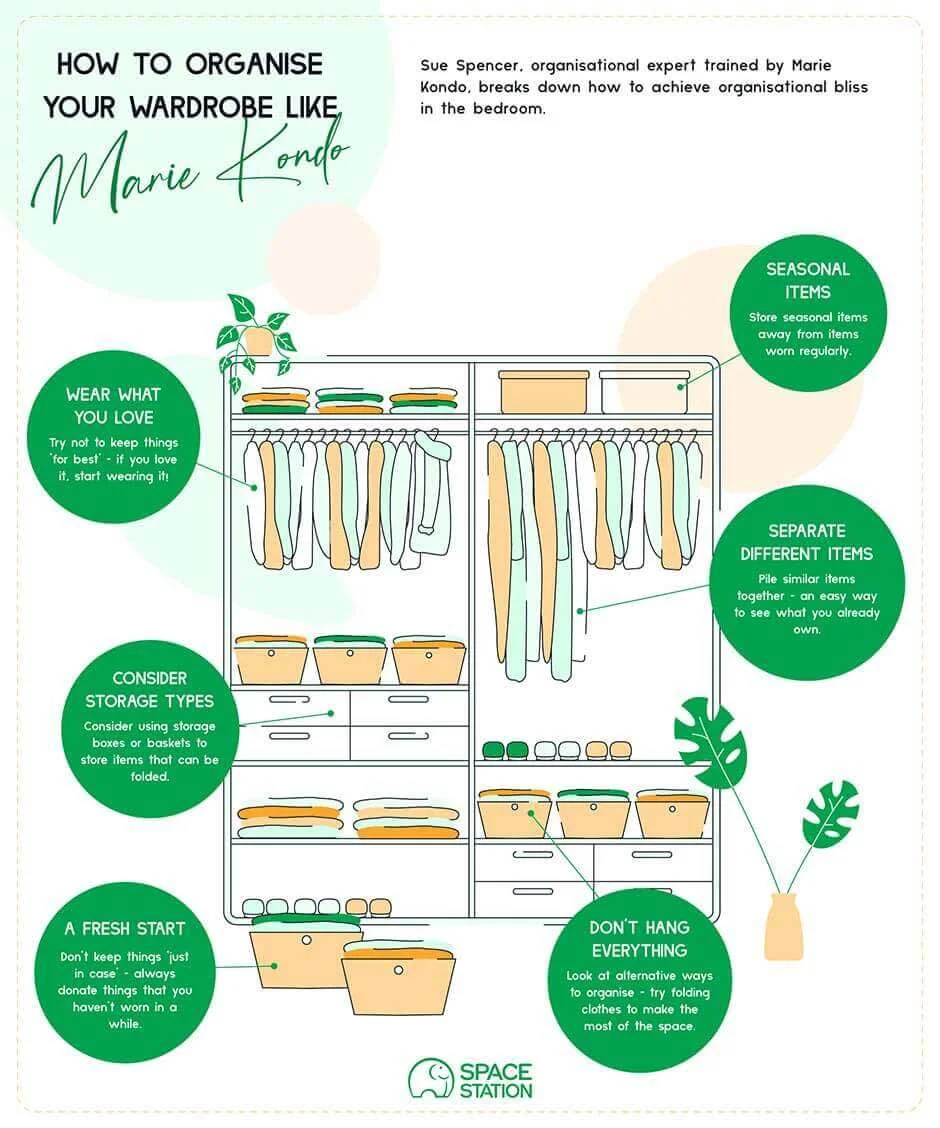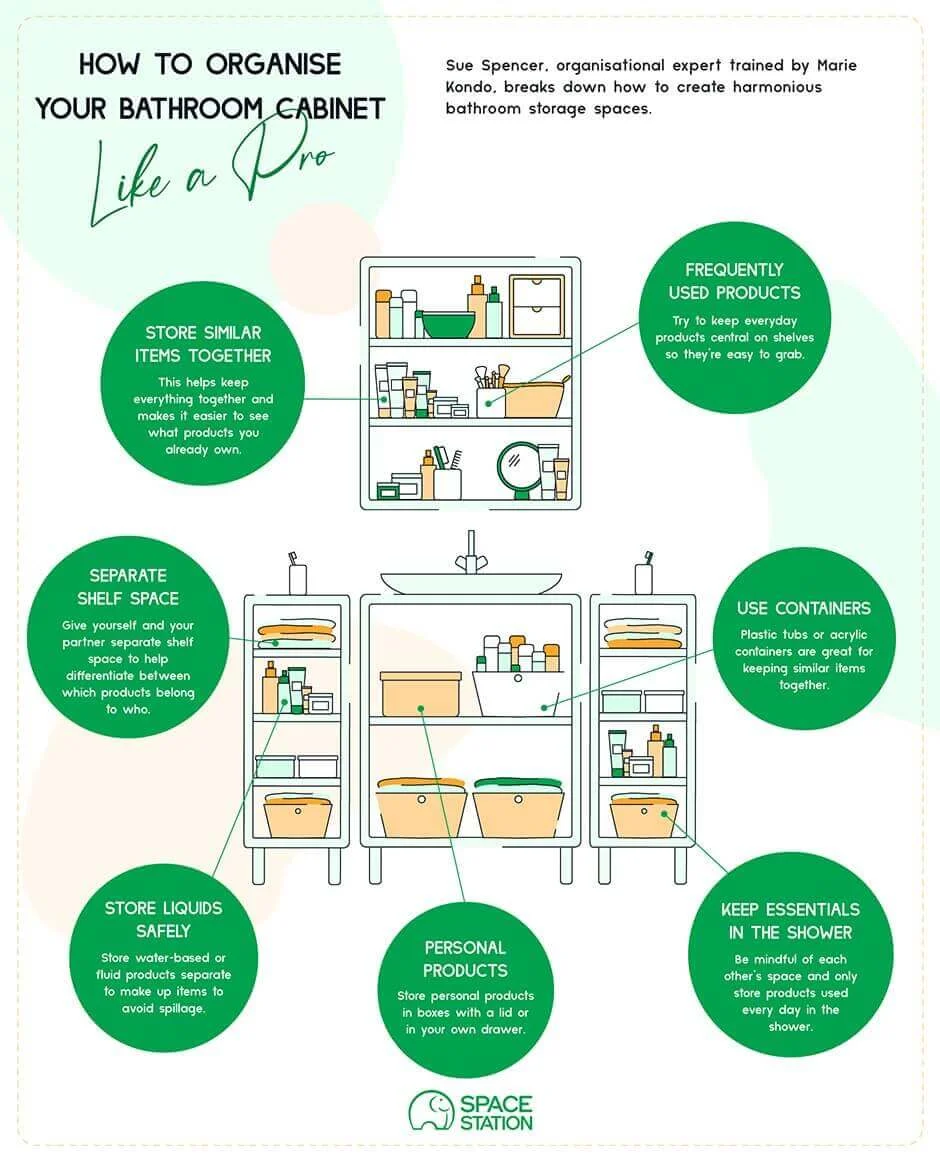One of the main bones of contention after moving in with your partner is often storage space and who gets to use what. Whether it is decided on an even share of the wardrobes or who needs more room in the bathroom cabinet, the dispute over space can lead to arguments and frustration.
In fact, our recent study shows more than one in five (22%) couples living under the same roof have arguments over space at least a couple of times a week.
With this in mind, we’ve teamed up with Marie Kondo home organisation expert, Sue Spencer, to reveal some simple tips for organising some of those key storage areas and avoiding these common disputes.
Wardrobes
You simply never seem to have enough wardrobe space and deciding who needs more room between you and your partner can be a difficult process. For that reason, Sue recommends a full audit of your wardrobes before re-organising them to get the most out of the space.

Sue’s tips for a successful wardrobe audit:
1. Before starting, think about how you’d like your wardrobe and bedroom to look. Browsing through magazines and Pinterest can inspire you and keep you motivated.
2. Put all your clothes in one place – I like to put everything on the bed. Separate the different types of garments (jumpers, dresses, suits etc) into piles. This is often when people are shocked to see how many similar items they own and find clothes they’ve forgotten they had.
3. If you’ve got lots of clothes it may be easier to manage one subcategory of clothes at a time (e.g. do tops first, then jeans, then suits.
4. Choose a pile to sort through – t-shirts or jumpers are an easy place to start. Look at the pile and select your favourite three tops that you really love wearing – think about why you like them, do they make you feel good, is it the colour you like or something else?
5. Once you’ve done this, set aside these items in your “keep” pile and work through the rest of the tops one at a time, holding each item in your hands to decide whether it’s something that you love. If it’s not obvious, compare it against your three top items to help you make the decision. If you don’t wear the item or it’s something you’ve kept hold of for quite a while to fit in to, now’s the time to let it go – put it in your discard pile (ready for the charity shop or eBay).
6. Continue with each category until you’ve made a decision about everything (including your socks!)
Sue’s tips on keeping your wardrobe organised:
1. Don’t keep things ‘just in case’ as the chances are if you haven’t worn it for years, you’re unlikely to again.
2. Don’t keep things ‘for best’ – if you love it then put it in your wardrobe and start wearing it, you’ll feel great every time you put it on!
3. When you’ve sorted all the clothes, look at your storage space and decide how you want to organise the items you love – not everything needs to be hung.
4. Jumpers, t-shirts and jeans can all be folded and put in chests of drawers or baskets on shelves to maximise storage.
5. Consider storing seasonal items under the bed so they don’t take up shared space. Bathrooms Bathrooms are often limited on space to store toiletries and towels, making it important to have it well organised to allow you and your partner to share the space harmoniously. As such, Sue has shared advice on conducting an audit of your bathroom storage and how to keep it in tip top shape.

Sue’s tips for a successful bathroom audit:
1. Gather all your toiletries, skincare, make up, even bathroom cleaners together and sort them into different categories (hair products, shower gel/soaps, moisturisers/face creams, perfumes/aftershaves, deodorants, make up, lipsticks, mascaras, nail varnish, etc). You can do this by person if it makes sense or merge the groups if you share products like shampoo. The tighter the category the better you’ll be able to see exactly what you have in the way of duplicate items.
2. Look at one category at a time and check that the items open are still in date – check the symbol on the container for shelf life and throw away any that are expired. Also check to see which products you actually use – there may be some that you bought and tried, but you didn’t like the fragrance, or you had a bad reaction to them – now is the time to move these on!
3. IMPORTANT! If it’s a joint item then you both have a say on whether to keep it or not – if one of you wants to keep it then it should stay (even if the other person isn’t keen!) The first rule of decluttering is that you don’t declutter someone else’s stuff.
4. As you work through each category, pull out the items that you definitely love using (Marie Kondo would say the things that ‘spark joy’) and use these as a benchmark to check whether you need to keep the other items. Be honest with yourself about whether you need or will use any similar items – do you really need five aftershaves if you only wear one? Similarly, with makeup, do you use five red lipsticks, nine different mascaras? Throw away any that you’re not going to use.
5. It may also help to consider whether things are for everyday use or special occasions – taking make up as an example – double check your special occasion make up fits with your current lifestyle.
6. If there are items that you find difficult to discard, get them out and start using them now – you will feel fantastic using that luxury perfume/aftershave/body lotion that you were keeping for a special occasion.
7. If one of you collects miniature toiletries from hotel bathrooms then now is the time to throw these out – they rarely get used and frequently end up being out of date.
Once you’ve been through this process, you’ll have a better awareness of what you have and what you use frequently, which will help to keep on top of the flow of things coming into your home.
Sue’s tips on how to keep your bathroom organised:
1. Give yourself and your partner separate shelf space or drawers in the bathroom (if one of you is taller then obviously, they get the top shelves)!
2. Try to keep the everyday products central on any shelves and at an easy to reach level so you can grab them quickly. Anything that’s less frequently used should be kept up high or stored in a vanity unit or bathroom caddy, so you know where it is, but it doesn’t crowd the everyday space.
3. If you keep products in the shower then be mindful of each other, so just keep the products you use every day in there – any ‘special’ products can be stored away from this area.
4. Store similar items together: This works for two reasons – you know exactly where things are when you’re rushing to get ready in the morning/evening and you can see exactly what you’ve got so you can check before buying something new.
5. Use plastic tubs, shoe boxes, iPhone boxes or little acrylic/plastic containers to keep the similar items together if you are storing them in a drawer – it goes without saying that you need to put things back in the right place once you’ve used them!
6. Consider storing more personal products in boxes with a lid or in your own drawer.
7. Store water based or fluid products (skincare, contact lens solution, cleansers) separate to things like make up – water based or fluid products can spill and will ruin make up items if they come into contact.
Moving in together is always an exciting time but inevitably does have its challenges along the way. Following this guidance should make sharing the space available in your home a lot easier and will also help you keep your living space tidy and well organised in general.
There are always ways to get more out of the space you have; to find out more information on some quick and easy storage hacks you can utilise around your home, visit our blog post.